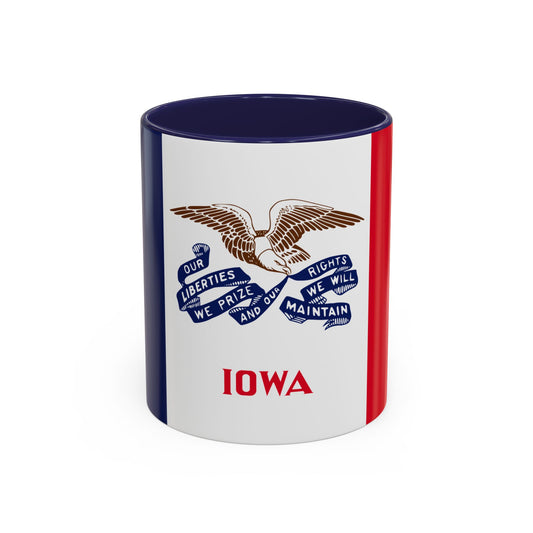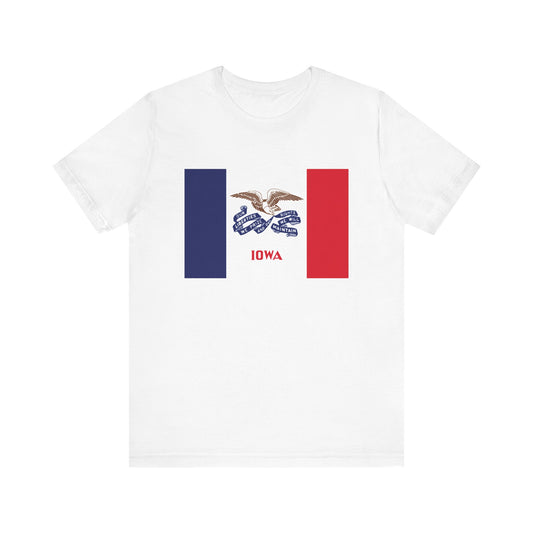-
Iowa Flag Sweatshirt
Regular price $34.15 USDRegular priceUnit price / per -
Iowa Sweatshirt
Regular price $34.15 USDRegular priceUnit price / per -
Iowa Backpack
Regular price $59.79 USDRegular priceUnit price / per -
Iowa Pillow
Regular price $22.65 USDRegular priceUnit price / per -
Iowa Trucker Cap
Regular price $14.90 USDRegular priceUnit price / per -
Iowa Leather Patch Hat
Regular price $18.85 USDRegular priceUnit price / per -
Iowa Hoodies
Regular price $34.40 USDRegular priceUnit price / per -
Iowa T-shirts
Regular price $22.79 USDRegular priceUnit price / per -
Iowa Flag Hoodies
Regular price $34.40 USDRegular priceUnit price / per -
Iowa Flag T-shirts
Regular price $22.79 USDRegular priceUnit price / per
Collection: US State: Iowa IA flag
The Iowa flag is a symbol of pride and history for the residents of the Hawkeye State. The flag is significant in the state's identity, from its unique design to its rich symbolism. We will explore the various aspects of the Iowa flag, including its design, historical context, symbolism, current relevance, and additional facts.
Overview of the Iowa Flag Design and Colors

The Iowa flag boasts a striking vertical tricolor pattern of blue, white, and red at the heart of its design. Each color on the flag carries a deep significance. The blue stripe symbolizes loyalty, justice, and truth, virtues foundational to the state's ethos. The central white stripe stands as a beacon of purity, a core value cherished by Iowans. The red stripe, bold and vibrant, symbolizes courage and bravery, reflecting the spirit of the state's people. Dominating the flag's center is a majestic bald eagle clutching a flowing blue streamer in its beak. This streamer bears the state motto, encapsulating the principles and beliefs that Iowa holds dear. The careful choice of colors and symbols interweaves the state's values with its visual identity, creating a flag that is not only distinctive but also deeply meaningful.
Historical Context: From Adoption to Present Day
Adopted on March 29, 1921, the flag of Iowa came into being in a period marked by national introspection and a rekindled sense of unity following the end of World War I. The adoption was largely influenced by Iowa's soldiers serving in the war, who felt the absence of a distinctive state flag when they saw other state banners flown by their fellow servicemen. This realization sparked a movement back home to create a symbol representing Iowa's unique values and heritage on the national stage. Dixie Cornell Gebhardt, a member of the Daughters of the American Revolution in Iowa, played a pivotal role in designing the flag, emphasizing themes of peace, patriotism, and the state's role in the broader context of the United States.
Since its adoption, the flag has remained unchanged, a testament to the enduring nature of the values and ideals it represents. Over the years, the flag has transcended its initial purpose, becoming an emblem of state pride and community for Iowans. It has witnessed historical changes, cultural shifts, and the evolution of Iowa itself, standing as a constant reminder of the state's resilience and unity. While the flag's inception was a response to a global conflict, its lasting significance has been defined by its ability to unite Iowans under a common banner of identity and purpose.
Symbolism Encoded in the Iowa Flag
The Iowa flag is rich with symbols that convey the state’s ideals and history. At the forefront, the bald eagle, a national emblem of freedom and might, clasps a blue streamer in its beak. This streamer is inscribed with the state motto, “Our liberties we prize and our rights we will maintain,” asserting Iowa’s commitment to freedom and justice. The eagle, positioned against the white background, symbolizes Iowa's integral role in the United States and its dedication to unity and peace.
The blue, white, and red tricolor mirrors the French Tricolor, paying homage to the French influence in Iowa’s early history, specifically through the Louisiana Purchase. This link also serves as a reminder of the principles of liberty, equality, and fraternity—values that resonate with the state's ethos. The blue stripe symbolizes loyalty and justice; the white stripe signifies purity and the value of truth; the red stripe represents courage and sacrifice. Together, these colors and symbols weave a narrative of Iowa’s past, present identity, and aspirations for the future, encapsulating the state’s commitment to preserving democracy and promoting the common good.
The Current Relevance of the Iowa Flag
Today, the Iowa flag continues to be a vital part of the state’s identity, serving multiple purposes in public and private spheres:
- State and National Events: The flag is common at official state events, from government ceremonies to public celebrations, symbolizing unity and state pride.
- Military and Civic Ceremonies: They play a significant role in military services and civic ceremonies, representing the honor and courage of Iowans past and present.
- Educational Use: Schools across Iowa use the flag as an educational tool to teach students about the state’s history, values, and government.
- Public Buildings: Displayed in all state buildings, they constantly remind one of the state's ethos and principles.
- Memorial Services: The flag is often flown at half-staff during memorial services to honor the lives of notable Iowans and fallen soldiers and show respect and mourning.
While the flag's design and symbolism have sparked some discussions, its presence at these varied events and locations underscores its ongoing relevance to Iowa's cultural and civic life.
Additional Facts and Protocols for the Iowa Flag
The protocols surrounding the Iowa flag emphasize respect and dignity in its display and handling. These guidelines ensure the flag is displayed prominently alongside the national flag, with the state flag taking a position of no greater prominence or honor. When flown with flags of other states, all should be displayed at equal height, showcasing unity and equal respect among the states. Regarding care, the flag should never touch the ground or be used in a manner that could be viewed as disrespectful.
Additionally, it is custom for the Iowa flag to be lowered to half-staff during significant state or national mourning periods, as a sign of respect and remembrance for individuals who have made considerable contributions to the state or nation. A fascinating protocol detail includes the flag being folded specifically during ceremonial events, mirroring practices with the national flag to signify unity and reverence. These protocols, established to honor and preserve the flag's dignity, play a crucial role in maintaining its symbolic value and significance in the hearts of Iowans.






















